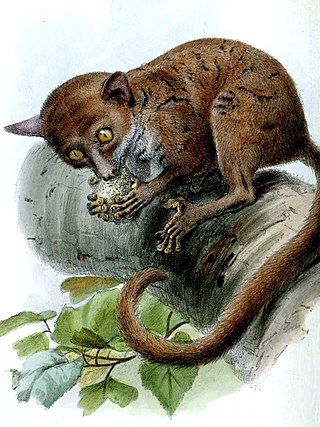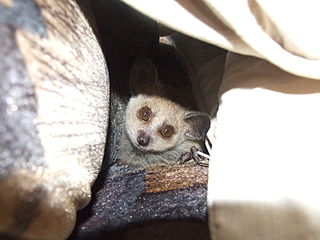
Galagos, also known as bush babies, or nagapies, are small nocturnal primates native to continental, sub-Sahara Africa, and make up the family Galagidae. They are considered a sister group of the Lorisidae.

The Senegal bushbaby, also known as the Senegal galago, the lesser galago or the lesser bush baby, is a small, nocturnal primate, a member of the galago family Galagidae.

Lesser bushbabies, or lesser galagos, are strepsirrhine primates of the genus Galago. They are classified, along with the bushbabies and the rest of the galagos, in the family Galagidae. They are probably the most numerous primate in Africa, and can be found in every large forest on the continent, inhabiting forested areas, savannas, riverine bush and open woodlands.

The greater galagos or thick-tailed bushbabies are three species of strepsirrhine primates. They are classified in the genus Otolemur in the family Galagidae.

The Zanzibar bushbaby, Matundu dwarf galago, Udzungwa bushbaby, or Zanzibar galago is a primate of the family Galagidae. An adult typically weighs 150 grams (5.3 oz), its head-body length is 14 to 15 centimetres and its tail is between 12 and 15 centimetres long. Like other species of galagos, its diet consists mainly of fruit, insects, and tree gums.

The Taita Hills, sometimes also spelled as Teita Hills, are a mountain range located in the Taita-Taveta County in south-eastern Kenya. The hills consist of three massifs: Dawida, Sagalla in the southern side of Voi township and Kasigau in the south near the border of Tanzania. The Dawida massif is the largest and tallest of the three, with an altitude of 2,228 metres (7,310 ft) above sea level at its highest peak, Vuria. Dabida has three other main peaks: Iyale, Wesu, and Susu.

The northern greater galago, also known as Garnett's greater galago, Garnett's galago, or the small-eared greater galago, is a nocturnal, arboreal primate endemic to Africa.

The northern needle-clawed bushbaby is a species of strepsirrhine primate in the family Galagidae. It is found in the coastal region of Cameroon and Nigeria, and on the island of Bioko, Equatorial Guinea in lower-elevation forests that provide its specialized diet of tree gum and resins.

Prince Demidoff's bushbaby, also known as Prince Demidoff's galago, is a species of primate in the family Galagidae. It is native to parts of tropical West and Central Africa.

The western dwarf galagos are a group of three species of strepsirrhine primates, native to western and central Africa. They are classified in the genus Galagoides of the family Galagidae. The eastern dwarf galagos have been moved to their own genus, Paragalago, based on genetic evidence and differences in vocalization. The two genera are not sister taxa and thus may have evolved their small sizes via parallel evolution. They are separated by the East African Rift.

The Somali bushbaby, or the Somali lesser galago, as it is also known, is a species of nocturnal, arboreal primate in the family Galagidae. It is found in Ethiopia, Kenya, and Somalia. It is threatened by habitat loss.

Grant's bushbaby, also known as Grant's lesser bushbaby or the Mozambique lesser bushbaby, is a species of primate in the family Galagidae. It is found in Malawi, Mozambique, Tanzania, and Zimbabwe. Its natural habitat is subtropical or tropical dry forests. It is a common species and the International Union for Conservation of Nature has assessed its conservation status as being of "least concern".

The dusky bushbaby is a species of primate in the family Galagidae. It is also known as Matschie's galago, in honour of the German zoologist Paul Matschie, curator of mammals at the Museum für Naturkunde in Berlin. Native to tropical Central Africa, it is found in forests in Burundi, Rwanda, Democratic Republic of the Congo and Uganda. The species is small with a long tail, and has an arboreal, nocturnal and omnivorous lifestyle.

The Rondo dwarf galago or Rondo bushbaby is a species of primate in the family Galagidae. The dwarf galagos are the smallest members of the genus Galagoides. It weighs less than 100 grams, making it the smallest known galago. It is endemic to Tanzania where its natural habitat is subtropical or tropical dry forests. It lives in an area reported in 2012 to be less than 100 square kilometers and is threatened by habitat loss due to logging. While it was discovered in the 1950s, the Rondo dwarf galago was deemed data deficient until 1996. In 1996, the Rondo dwarf galago was fully described as a species. It is now listed as one of "The World's 25 Most Endangered Primates."
The Kenya coast galago is a species of primate in the family Galagidae. It is found across Kenya and Tanzania, particularly around the northern coastal area of each of the countries, and has been located living from sea level to around 350 metres (1,150 ft) above sea level.
The Angolan dwarf galago is a species of dwarf galago native to Angola, and was named after western Angolan Kumbira Forest. Though 36 individuals of the Angolan dwarf galago were identified in September 2013, it was declared as a new species in 2017, and is now the nineteenth species of galago to be identified. Its call, described as "A loud chirping crescendo of longer notes, followed by a fading twitter", was enough to separate it as a new species, without any genetic identification, due to its uniqueness.

The eastern dwarf galagos are a group of five species of strepsirrhine primates of the family Galagidae, native to East Africa. They were formerly classified in the genus Galagoides but have been moved to their own genus, Paragalago, based on genetic evidence, and supported by differences in vocalizations and morphology. The three western/Congolian species remain in Galagoides.














